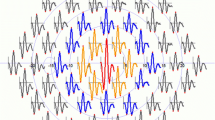Abstract
The value of pattern electroretinography (PERG) for the detection and differentiation of senile macular degeneration (SMD) was assessed. A group of patients with atrophic SMD and a group with exudative SMD were compared with an age-matched reference group. Differences were only found in visual acuity and in the amplitude of the negative peak N95. No statistical differences between the atrophic and exudative groups were found. Conclusions may be drawn from these results with regard to the use of PERG in senile macular degeneration.
Similar content being viewed by others
References
Bressler NM, Bressler SB, Fine SL. Age-related macular degeneration. Surv Ophthalmol 1988; 32: 375–413.
Ferris III FL. Senile macular degeneration: review of epidemiologic features. Am J Epidemiol 1983; 118: 132–151.
Liebiwitz H, Krueger D, Maunder L. The Framingham Eye Survey, VI: Macular degeneration. Surv Ophthalmol 1980; 24: 428–435.
Vinding T. Occurrence of drusen, pigmentary changes and exudative changes in the macula with reference to age-related macular degeneration. An epidemiological study of 1000 individuals. Acta Ophthalmol 1990; 68: 410–414.
Bressler NM, Bressler SB, West SK, Fine SL, Taylor HR. The grading and prevalence of macular degeneration in Chesapeake Bay watermen. Arch Ophthalmol 1989; 107: 847–852.
Green WR, McDonnell PJ, Yeo JH. Pathological features of senile macular degeneration. Ophthalmology 1985; 92: 615–627.
Adachi-Usami E. Senescence of visual function as studied by visually cortical potentials. Jpn J Ophthalmol 1990; 34: 81–94.
van Lith GHM. The macular function in the ERG. Doc Ophthalmol Proc Series 1976; 10: 405–415.
Lorenz R, Niepel G, Heider W. Amplituden- und Latenzanderungen im Muster-Elektroretinogramm (M-ERG) bei Netzhaut- und Sehnervenerkrankungen. Fortschr Ophthalmol 1988; 85: 296–300.
Sunness JS, Massof RW, Johnson MA, Finkelstein D, Fine SL. Peripheral retinal function in age-related macular degeneration. Arch Ophthalmol 1985; 103: 811–816.
Oguchi Y, Koornstra-Lunt SF, van Lith GHM, Witzier A. Electroophthalmology in senile macular degenerations. Doc Ophthalmol Proc Series 1976; 10: 103–115.
Sherman J. Simultaneous pattern-reversal electroretinograms and visual evoked potentials in diseases of the macula and optic nerve. Ann NY Acad Sci 1982; 388: 214–226.
Sokol S. Visually evoked potentials: theory, techniques and clincal applications [Review]. Surv Ophthalmol 1976; 21: 18–44.
Bartl G, van Lith GHM, van Marle GW. Cortical potentials evoked by a TV pattern reversal stimulus with varying check sizes and stimulus field. Br J Ophthalmol 1978; 62: 216–219.
Bartl G, van Lith GHM, van Marle GW. Cortical potentials evoked by a TV pattern reversal stimulus with varying check sizes and position of the stimulus field. Ophthalmic Res 1978; 10: 295–301.
Skrandies W, Leipert KP. Pattern ERGs and VEP topography evoked by lateral eccentric pattern reversal stimulation. Intern J Neuroscience 1988; 39: 137–146.
Yoshii M, Paarmann A. Hemiretinal stimuli elicit different amplitudes in the pattern electroretinogram. Doc Ophthalmol 1989; 72: 21–30.
Cobb WA, Morton HB, Ettlinger G. Cerebral potentials evoked by pattern reversal and their suppression in visual rivalry. Nature 1967; 216: 1123–1125.
Arden GB, Carter RM, Hogg C, Siegel JM Margolis S. A gold-foil electrode extending the horizons for clinical electroretinography. Invest Ophthalmol Vis Sci 1979; 18: 421–426.
Dawson WW, Maida TM. Relations between the human cone and ganglion cell distribution. Ophthalmologica 1984; 188: 216–221.
Maffei L, Fiorentini A. Electroretinographic responses to alternating gratings before and after section of the optic nerve. Science 1981; 211: 953.
Arden GB, Carter RM, MacFarlan A. Pattern and Ganzfeld electroretinogram in macular disease. Br J Ophthalmol 1984; 68: 878–884.
Holder GE. Significance of abnormal pattern electroretinography in anterior visual dysfunction. Br J Ophthalmol 1987; 71: 166–171.
Kirkham TH, Coupland SC. Abnormal pattern electroretinograms with macular cherry-red spots: Evidence for selective ganglion cell damage. Curr Eye Res 1981; 1: 367–372.
Persson HE, Wanger P. Pattern-reversal electroretinograms in squint amblyopia, artificial anisometropia and simulated eccentric fixation. Acta Ophthalmol 1982; 60: 123–132.
Author information
Authors and Affiliations
Rights and permissions
About this article
Cite this article
Sanders, D.G.M., Van Lith, G.H.M. Pattern electroretinography in senile macular degeneration. Doc Ophthalmol 78, 189–193 (1991). https://doi.org/10.1007/BF00165680
Accepted:
Issue Date:
DOI: https://doi.org/10.1007/BF00165680




